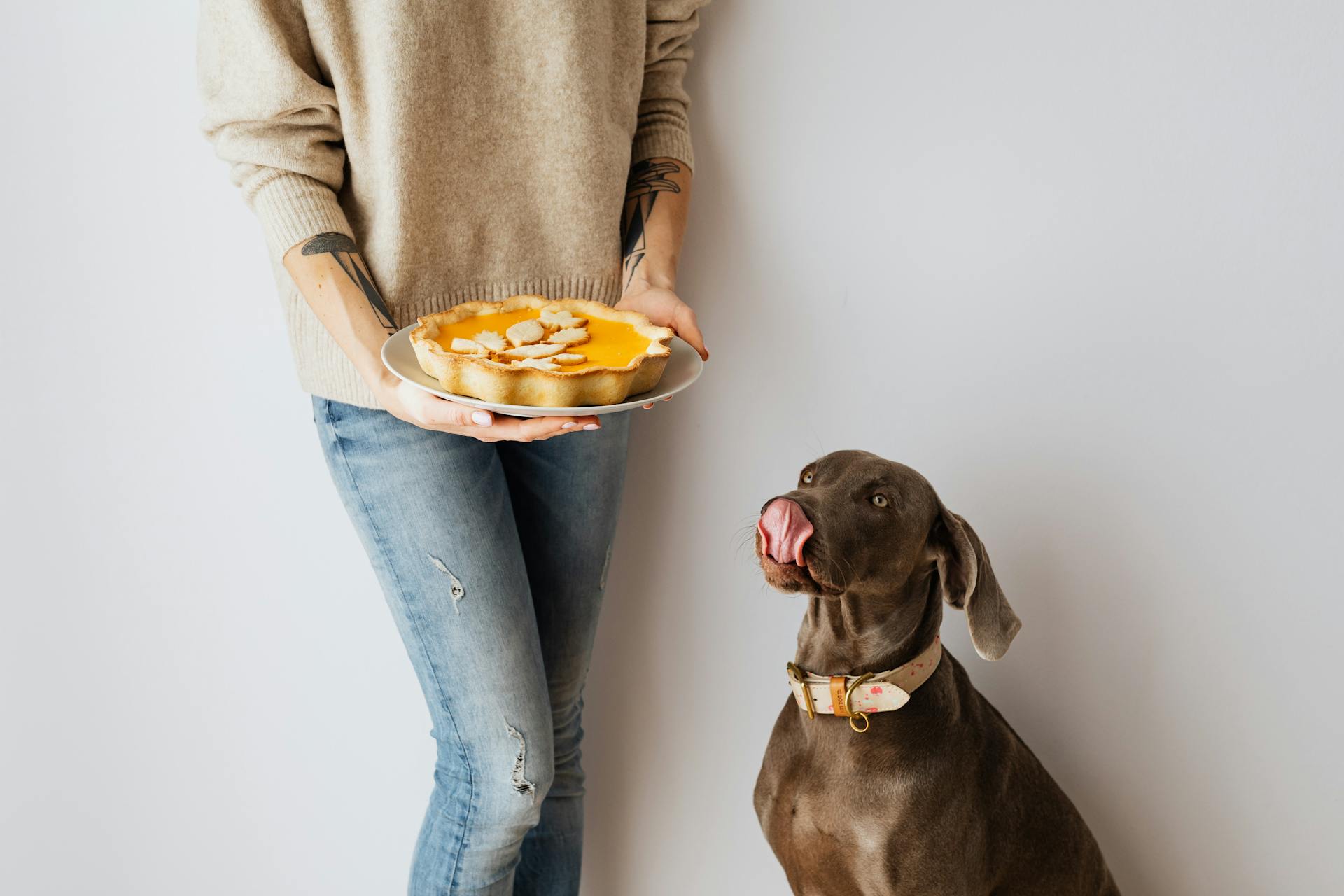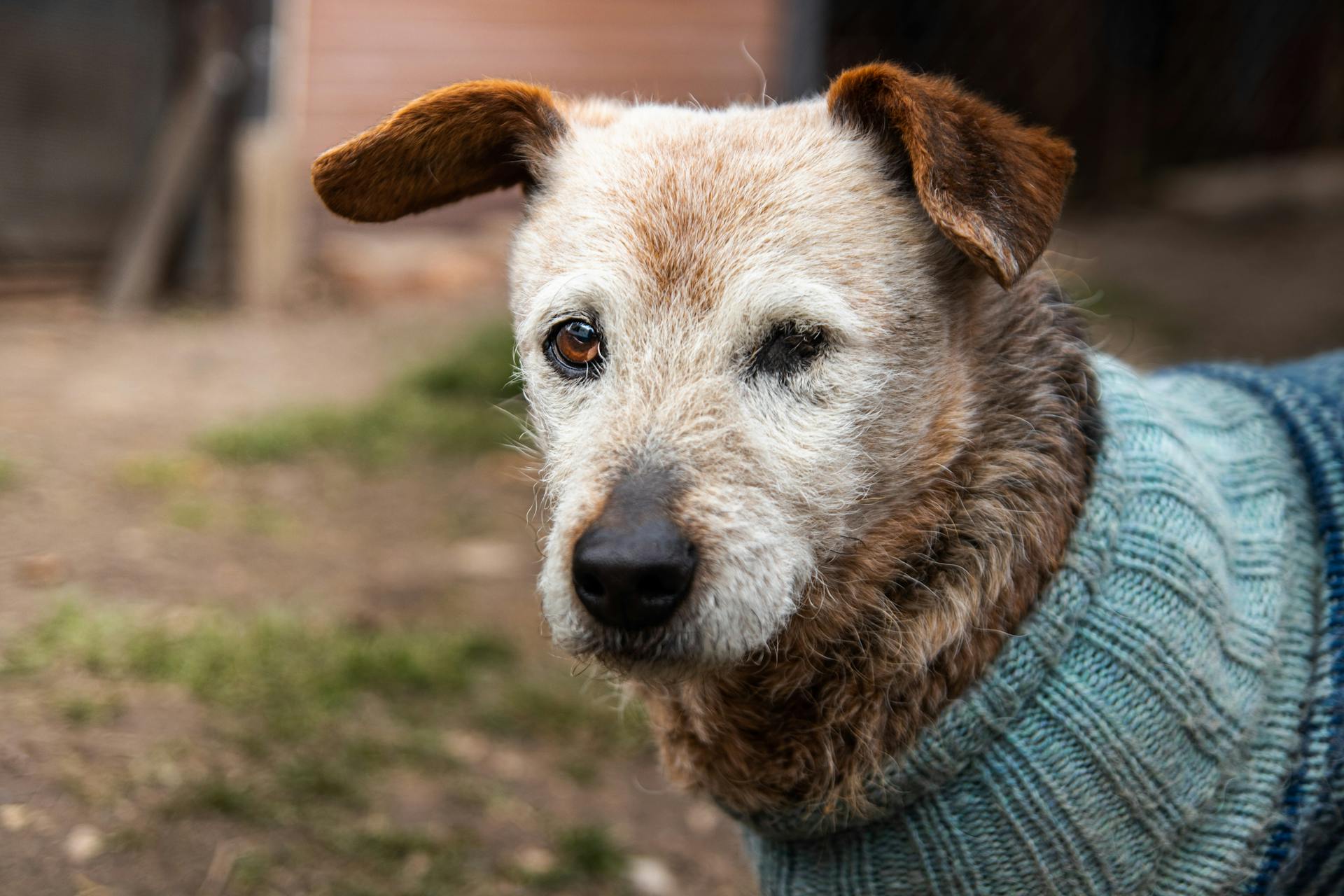
Deciding the best age to breed a dog can be a daunting task, but understanding the ideal breeding age can make all the difference. Most breeders agree that a dog's reproductive prime is between 1.5 and 2.5 years old.
At this age, dogs have reached physical maturity and are capable of producing healthy offspring. Research suggests that breeding a dog too early can lead to complications and health issues in the puppies.
Breeding a dog that's too old can also have negative consequences, such as reduced fertility and an increased risk of genetic disorders.
Expand your knowledge: Dog Training Age
Breeding Basics
Breeding a dog for the first time isn't always as easy as it seems. You need to meet the relevant legal breeding requirements for your state.
Research is key to a successful breeding process. Take your time to learn about dog breeding and enjoy the process of searching for a suitable stud dog.
To ensure the breeding process runs smoothly, you need to research the health testing requirements for your breed. This will give your dog the best chance of conceiving a healthy litter of puppies.
Discover more: Best Time to Breed Dogs
Female Breeding Age
Breeding a female dog requires careful consideration of her age and physical maturity. In some states, such as NSW, you must not intentionally mate a bitch during her first cycle.
The minimum age for breeding a female dog varies by breed and size. Large breeds like Labradors and Golden Retrievers are fully grown between 18 and 24 months of age, while giant breeds like St Bernards and Great Danes may not reach full maturity until they're around 30 months old.
Breeding a female dog too early can lead to health problems for both the dam and her puppies. Research has shown that breeding a female dog before she's physically mature can result in dystocia, a difficult delivery.
DNA testing can be carried out at any age, but testing for hip and elbow abnormalities typically requires dogs to be at least 12 months old. This is particularly important for breeds prone to hip and elbow dysplasia, such as Golden Retrievers and Labrador Retrievers.
For your interest: I Want to Breed My Female Dog
A Swedish analysis of over 200,000 dogs found that 23-24% of bitches experienced pyometra (a uterine infection) by 10 years of age. This highlights the importance of considering a female dog's age and health when deciding whether to breed her.
Here's a rough guide to the age ranges for different breeds:
It's essential to weigh up the risks and benefits of breeding a female dog at different ages. While some breeds may be ready to breed earlier, others may need more time to mature. Ultimately, the decision to breed a female dog should be based on her individual needs and health status.
See what others are reading: Male Dog or Female Dog
Breeding Intervals
Breeding intervals are an essential consideration when deciding when to breed a dog. In NSW, you're required to give a female dog a break after breeding her twice in a row, and she can only have two litters every two years unless you have written approval from a vet.
Curious to learn more? Check out: Shih Tzu Breed Problems
The laws in Queensland are a bit more specific, requiring a breeding female to have a break after two litters in an 18-month period. This means that if you live in Queensland, you'll need to plan your breeding schedule carefully to ensure you're not pushing your female dog too hard.
In Queensland, there are also specific requirements for breeding females, including that they must be physically mature, fit and healthy, or have written approval from a vet that they're ready for breeding. This is a great reminder to always prioritize the health and well-being of your dog.
Here's a summary of the breeding intervals in NSW and Queensland:
Male Breeding
Breeding a male dog can be a complex process, and it's essential to consider his age and health before making a decision.
Male dogs can breed at any age, but their fertility declines significantly after the age of 10.
A male dog's ability to breed can be affected by his size, with larger breeds typically having a longer breeding lifespan than smaller breeds.

A study found that a male dog's fertility peaks between 2-5 years of age, but it's essential to consider his overall health and well-being before breeding.
In some breeds, such as the Poodle, males can breed until they are 12 years old, but this can vary depending on individual factors.
Male dogs that are too old or too young may not be able to breed successfully, so it's crucial to consider their age and health before making a decision.
Heat Cycle and Mating
The heat cycle and mating season are crucial factors to consider when deciding the best age to breed a dog. Smaller dogs tend to have a shorter mating season than larger dogs, but they also reach sexual maturity faster.
Dogs in poor physical condition may be less able to withstand the rigors of mating and birthing, making it essential to ensure they're healthy enough for breeding. Medications used to treat health conditions can even cause spontaneous miscarriages.
The heat cycle in dogs has four distinct stages: proestrus, estrus, diestrus, and anestrus. Here are the stages in brief:
- Proestrus (lasts around nine days): The dog's body prepares for ovulation, and estrogen hormone levels rise.
- Estrus (lasts around nine days): Ovulation occurs, and fertility in dogs is at its highest.
- Diestrus (60–90 days): The reproductive tract is dominated by progesterone, and this stage lasts until the dog gives birth or 2–3 months if she doesn't get pregnant.
- Anestrus (3–4 months): The reproductive tract is inactive, and no eggs are released.
Phases of the Heat Cycle
The heat cycle in dogs is a complex process, but understanding its phases can help you better care for your furry friend. The cycle consists of four distinct stages: proestrus, estrus, diestrus, and anestrus.
Proestrus typically lasts around nine days and is characterized by a rise in estrogen levels, causing the lining of the uterus to thicken in preparation for pregnancy. Your dog may seem restless and may exhibit a swollen vulva.
During estrus, ovulation occurs, and fertility in dogs is at its highest. This stage also lasts around nine days and is crucial for mating.
The diestrus stage can last anywhere from 60 to 90 days, during which the reproductive tract is dominated by progesterone. If your dog doesn't get pregnant, this stage lasts 2-3 months, but if she does get pregnant, it lasts until she gives birth.
Related reading: Best All around Dog Breed
Anestrus is the resting phase of the heat cycle, lasting around 3-4 months, during which the reproductive tract is inactive, and no eggs are released or hormones produced. Your dog may not show any signs of being in heat during this stage.
Here's a quick rundown of the heat cycle phases:
Mating Season Influences
Smaller dogs tend to have a shorter mating season than larger dogs. They also reach sexual maturity faster.
The size of a dog can affect the length of the estrous cycle. Smaller dogs often have shorter estrous cycles than larger breeds.
Dogs suffering from health issues like sexually transmitted infections, lymphoma, tumors, or genetic mutations may be less interested in breeding. This is because these conditions can decrease libido or make the pup infertile.
A dog in poor physical condition may struggle with the demands of mating and birthing. Medications used to treat health conditions can even cause spontaneous miscarriages.
Pregnancy Science
Pregnancy in dogs is a complex process, and understanding the science behind it can help you make informed decisions about breeding.
Dogs can become pregnant at a relatively young age, with some breeds reaching maturity as early as 4-6 months old. This is because their reproductive system is already developed at birth.
A healthy puppy can be born after a gestation period of around 58-68 days, which is relatively short compared to other mammals. This is because dogs have a unique reproductive biology that allows them to produce multiple litters in a short amount of time.
Pregnancy in dogs is triggered by a process called ovulation, where the female dog releases eggs into her reproductive tract. This usually occurs around 10-14 days after mating.
The number of puppies in a litter can vary greatly, with some breeds averaging 5-10 puppies per litter. Factors such as breed, age, and overall health can all impact the number of puppies born.
A female dog can have multiple litters in her lifetime, with some breeds capable of producing up to 2-3 litters per year. This is because their reproductive system is designed to produce multiple offspring in a short amount of time.
Expand your knowledge: Yorkshire Terrier Litter Size
Frequently Asked Questions
How many times should you breed a female dog in her lifetime?
For a healthy female dog, it's recommended to breed no more than 4 to 6 times in her lifetime to ensure her health and the health of her puppies. This helps prevent potential health risks associated with frequent breeding.
Is it okay for a 1 year old dog to get pregnant?
For a healthy pregnancy, it's recommended to wait until your dog is fully grown, typically between 1-3 years old, depending on breed size. Waiting until your dog reaches full maturity can help minimize health risks associated with pregnancy.
Sources
- https://studdogsonline.com/breeding-age-of-dogs-limits-frequency-and-state-laws-in-australia/
- https://petpedia.co/what-age-can-you-breed-a-female-dog/
- https://wagwalking.com/sense/what-age-can-dogs-get-pregnant
- https://pattonvethospital.com/blog/98112-by-what-age-should-i-spay-or-neuter-my-large-breed-dog
- https://buzzardsbayvetassociates.com/blog/choosing-the-best-age-to-spay-or-neuter-your-dog
Featured Images: pexels.com


